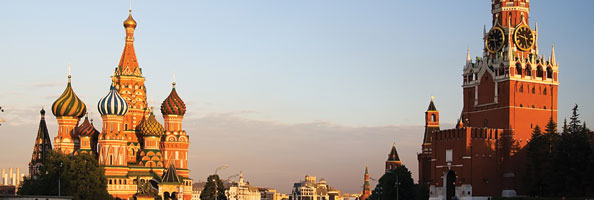- Classic Destinations
- Italy
- France
- United States
- Caribbean
- Canada
- off the beaten path
- Romania
- Georgia (Country)
- Rwanda
- Myanmar
- Corsica

“European, Asian and Stalinist architecture all in one place; an illustration of Russia’s schizophrenic personality.” —AH
From Joe Colucci, Travel Consultant in the Andrew Harper Travel Office: “Red Square is an ideal place to witness the contrasts of history and architectural styles in Moscow. At the entrance, you have the Hotel Moscow, built in the Socialist Constructivist style under Stalin. Nearby loom the colorful onion domes of the Russian Orthodox Saint Basil’s Cathedral. Lining the eastern side of the square is the late 19th-century GUM department store; Stalin converted it into offices for his committees, and it now houses glamorous shops like Burberry and Hermes. Also, a ride on the metro is like taking a tour through Moscow’s eclecticism. Some stops are in the grand Stalinist Baroque style, some are bare Cold War era, and others have beautiful mosaics and busts of Lenin. Each is a museum of its own.”

“The crumbling temples and ashrams lining the Ganges that are at the heart of Indian culture.” —AH
From Somnath Mukherjee, General Manager of Nadesar Palace: “Varanasi is one of India’s seven holy cities, places believed to be gateways to divine realms. We have here some of the most sacred temples dedicated to Lord Shiva, like the magnificent Kashi Vishwanath. Not far from our hotel winds the Ganges, where you can see pilgrims at sunrise, waist deep in the holy waters, doing ablution and devoutly offering their prayers to the rising sun. A boat ride along the Ganges at dawn or at dusk is a mesmerizing experience. The majestic ancient temples and spirituality here can allure anyone to lose themselves amid the hustle and bustle of one of the oldest living cities in the world.”

“The wooden temples of the Zen monasteries, the so-called Five Great Zen Temples of Kyoto, Nanzen-ji, Tenryu-ji, etc.” —AH
From Emiko Sakaoka, guide for Abercrombie & Kent Tours in Kyoto: “The Five Great Zen Temples of Kyoto are a beautiful way to see how architecture can express a spiritual practice. For example, in Kennin-ji, founded in A.D. 1202, you can see the typical Zen-style building layout: the san-mon (a doorless gate of symbolic importance), the hatto (Dharma Hall) and the hojo building (abbot’s quarters) in a straight line. The hojo building’s coppercovered roof has a beautiful, gentle line. What I also like about this temple is the contrast of a quiet Zen temple and the surrounding area of Gion, which is known for geisha girls. At the temple known as Tofuku-ji, founded in A.D. 1255, you get a combination of traditional Zen temple buildings with the modern garden design of Mirei Shigemori, one of the most famous garden designers of the 20th century.”

“Spanish colonial mansions built on top of Incan ruins illustrate the collision of Old and New World civilizations.” —AH
From Jose Pilares Caceres, Concierge of Hotel Monasterio: “You can truly feel the culture and history of the Inca in Cusco, both in the pre-Conquest architecture, and with the Incas’ modern descendents, the Quechua, who are a vibrant part of life in this area today. Coricancha, a famous Incan temple, is one of the best places to witness the merger of Spanish and Incan architecture. Once dedicated to the Incan sun god and lined in gold, the Spaniards built over it, transforming it into the Convent of Santo Domingo. But you can still see the ancient, sophisticated Incan stonemasonry there. You can also imagine the Incan past at SacsayhuamaÅLn, an archeological site overlooking Cusco—it was once the temple of the lightning god, but now modern Peruvians celebrate the winter solstice there every June 24.”
“The view of this great Islamic city from the Palais Jamai overlooking the medina hasn't changed since the Middle Ages. Arab civilization at its height.” —AH
From Jemima Mann-Baha, co-owner of Palais Amani: “Fes is over 1,200 years old and has the largest medina in the world, a vast labyrinth of narrow alleyways navigated only on foot or by donkey. These alleyways take you into another time, and allow visitors to experience life as it was when the city was first established. Once in the medina, you cannot imagine what lies behind the high crumbling walls and unremarkable doors that border the narrow streets. But if you push a door and step inside you move from a dusty paved alley to magnificent gardens with citrus fruit trees and huge mosaic fountains, or intricately decorated Koranic schools and places of worship. It’s a wonderful place to get lost; taking a wrong turn invariably brings you to a whole different experience and feast for the eyes.”
Excerpted from Andrew Harper Traveler magazine.
Read part one of Andrew Harper's Favorite Architecturally Inspiring Destinations.